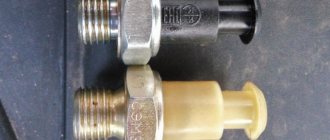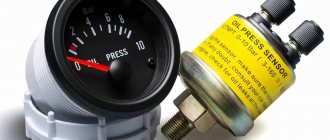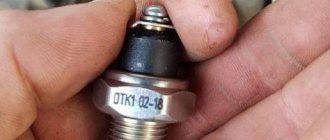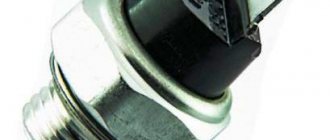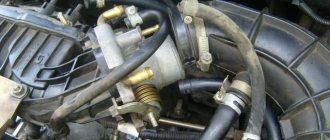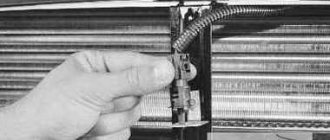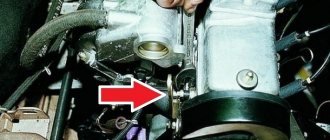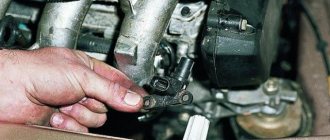03.03.2022 10 205 VAZ Priora
Author: Ivan Baranov
You can monitor the condition and level of lubrication of the car by measuring the oil level using a dipstick. In modern cars, this is monitored by an electronic control unit; for this purpose, a Priora emergency oil pressure sensor is installed. What this device is, how to check it, what malfunctions exist and how to replace it yourself is described in this article.
[Hide]
What you need to know about DDM?
The regulator in question is an important element of the lubrication system of the Lada Priora car, equipped with an electronic control unit (video author – SoftFelix).
Purpose and location
The indicator is designed to warn the driver of insufficient oil pressure. It is located on the engine cylinder head near the oil filter under the exhaust manifold. To carry out diagnostics, the device must be removed.
Location in the engine compartment
The operating principle of the device is simple. Under pressure, the membrane gasket bends and changes its shape. It acts on contacts that close or open.
Device operation diagram
Typical malfunctions and methods for their elimination
If the oil pressure warning light does not come on when the ignition key is in the “on” position, the following malfunctions are possible:
- broken wiring;
- the light bulb burned out;
- the regulator is faulty;
- bad contact.
A broken wire is looked for using a test light and repaired by replacing the damaged wire. The burnt out light bulb is replaced with a new one. To eliminate the cause of poor contact, you need to clean the connections and check the reliability of the wire connections. A faulty regulator should be replaced.
DDM on Lada Priora
Design Features
The oil pressure sensor on a Priora with an engine with 16 and 8 valves is located under the exhaust manifold pipe on the cylinder head, on the oil channel. Structurally, the controller is a transmission mechanism with a membrane built inside. When the oil level is sufficient, the diaphragm is in the maximum curved position, the contact group that transmits the signal to the instrument panel is inactive. When the oil level decreases, the membrane bends, the contacts close, an alarm signal is sent to the alarm, and the red indicator lights up.
Checking the oil pressure sensor begins with inspecting the oil filter and checking the power supply. In most cases, the cause of an incorrect signal is worn-out wiring, oxidized contacts, or a burnt-out dashboard light bulb where the indicator is located.
It is necessary to check the functionality of the part every time the engine is started; when the ignition key is turned to the “on” position, the indicator should light up for a few seconds. If this does not happen, all adjacent parts are working correctly, the sensor will need to be checked and replaced.
Alarm indication
Of course, now in almost all cars there is an emergency indication for a complete lack of pressure, this is known to us all - a “burning oil can”. If it does not go out for some time after starting, for example 10 - 20 seconds is one thing, it is almost always the fault of the oil filter. But if the lamp is constantly on, then this is already an alarm bell. Perhaps the oil pressure sensor has simply failed, or perhaps the oil pump has failed.
In any case, the emergency indication is very important, and I do not advise you to joke with it; nevertheless, this is fraught with a major overhaul of the engine.
Remember this rule, if the lamp comes on, then turn off the car and preferably immediately to a service station, either a tow truck, or in tow.
Typical malfunctions and methods for their elimination
If the oil pressure warning light does not come on when the ignition key is in the “on” position, the following malfunctions are possible:
- broken wiring;
- the light bulb burned out;
- the regulator is faulty;
- bad contact.
A broken wire is looked for using a test light and repaired by replacing the damaged wire. The burnt out light bulb is replaced with a new one. To eliminate the cause of poor contact, you need to clean the connections and check the reliability of the wire connections. A faulty regulator should be replaced.
DDM on Lada Priora
Sensor cost
The Lada Priora comes from the factory with the original oil pressure sensor 11180-3829010. Its price ranges from 180 to 250 rubles. Third-party manufacturers produce analogues for the native DDM. Some of them are of decent quality while maintaining an affordable price. The best alternative options for a branded product are presented in the table below.
Table - Good analogues of the original Lada Priora oil pressure sensor
| Firm | Catalog number | Approximate cost, ruble |
| AMY | 6022.3829-01 | 75-150 |
| Road map | 11183829010 | 75-90 |
| Baker | 11183829010 | 80-130 |
| Autodevice | 1118-3829010 | 110-185 |
| Bautler | BTL1118OPS | 120-160 |
Where is the oil pressure sensor located on the 16-valve VAZ-2112?
If suddenly the oil pressure indicator light on the dashboard of your car lights up, one of the reasons for this phenomenon may be not only low oil pressure, but the failure of the sensor that records the internal pressure of this engine lubrication element. You will learn how to properly replace it, as well as diagnose its malfunction, below in our article. Fortunately, it won’t take much time to replace this device.
Where is the oil pressure sensor located?
The oil pressure sensor is marked with an arrow and a circle
On 16-valve VAZ-2112 engines, the sensor is located on the left side of the engine, at the end of the housing near the camshaft bearings.
Purpose of the sensor
The oil pressure sensor is designed to promptly and accurately inform the driver about low lubricant pressure inside the internal combustion engine. So, as soon as the rapid detection of such a malfunction will allow you to avoid unnecessary problems and even greater engine breakdowns in the shortest possible time. It's no secret that dry engine operation can cause very serious damage to the engine. But on the other hand, you shouldn’t immediately panic and draw conclusions; it’s enough to first check the sensor itself.
Mistakes in hasty conclusions
When the oil pressure light comes on, many car owners sound the alarm and begin to fix this problem in all but not the most important ways, and these include:
- Oil change and fuel filter replacement.
- It is washed.
- The pressure is measured.
But after this, the result does not happen! Therefore, always check the oil pressure sensor first, as this is the most common and common cause.
Sensor check
It is necessary to check the functionality of the sensor in the following order:
- We remove the wire from the sensor and lean it against ground, possibly on the motor housing.
- Check to see if the light on the instrument panel lights up again.
- If the lamp stops burning, then the wiring is working properly and you can move on to the next stage of dismantling the faulty sensor.
- And if it continues to burn, then it is necessary to “ring” the wires at the entire stage from the sensor to the instrument panel to detect a breakdown or short circuit in the circuit.
Replacing the oil pressure sensor
To work, we only need a “21” wrench.
We make the replacement as follows:
- When the sensor is detected, we clean its surface and around it from dirt and deposits so that some of the dirt does not get into the engine.
- Then disconnect the power supply from it.
When dismantling, we inspect it for defects and damage.
It's easy enough to rip off the nut and then just unscrew it by hand.
Pay attention to the quality of the connection.
In this simple way, the work on replacing the sensor can be considered completed.
Replacing the “limit switch”
And there is no difficulty here. Without turning on the ignition, you need to follow the procedure from step 2 to step 5. After that, wipe the area around the device with a rag or rag. This is necessary to ensure that no debris accidentally gets into the hole.
Using a socket wrench, unscrew the sensor and insert a new one. Tighten well until the gasket ring fits tightly into place. Check as described in the verification chapter. After this, start the engine and wait until the lamp goes out.
All this applies to the Priora equipped with a 16-valve engine.
In very small quantities, this model is produced with an 8-valve engine. There, this sensor is also located in the head, but only at the back. Directly under the manifold, on the interior side. Near the timing belt. Like on regular VAZ 2108 and so on. Otherwise, all actions are similar.
Very useful video in pictures. It shows the process of replacing this unit on a 2112 engine. This is an absolutely identical process with the Priora engine with 16 valves.
Methods for checking the oil pressure sensor
The price of an oil pressure sensor is very low. Therefore, many car owners, if they suspect problems with their original DDM, buy a new one and replace it. If after this the operation of the low oil pressure indication system has returned to normal, then the previously installed sensor has exhausted its service life.
You can indirectly check the serviceability of the sensor using a voltmeter or multimeter. To do this, you need to check the presence of voltage at the terminal block suitable for the DDM. If there is no power, then the problem should be looked for in other places besides the sensor. Checking the DPM is possible using a pressure gauge. It is necessary to screw it into the seat instead of the sensor. After this, the power unit starts. If the pressure gauge shows a pressure of less than 0.65 kgf/cm2, and the indicator does not light up from the sensor, then the DDM must be replaced.
It is not very accurate, but still allows you to determine the serviceability of the DDM that closes the indicator circuit using the method presented below.
- Unscrew the sensor.
- Start cranking the engine with the starter, preventing it from starting.
- Inspect the mounting hole of the unscrewed sensor. If oil leaks from it, then the DDM gives false signals and needs to be replaced.
The method presented below is the most popular among car owners. It gives decent accuracy.
- Take a hose 25 cm long.
- Connect the pump to the hose.
- Insert the sensor on the other side of the pipe.
- Check resistance. It should be minimal.
- Pump air to a pressure of more than 0.65 kgf/cm2.
- Recheck resistance. The device should show a gap.
Diagnostics of DDM on Lada Priora
Controllers for Priora cannot be repaired, since the main failure of the part will be rupture of the membrane or oxidation of the contacts of the closing group. The cost of a spare part is in the range of 100–200 rubles, so it is more advisable to replace the part. Sensor diagnostics are carried out in two ways:
- pressure gauge;
- mechanically.
Checking with a pressure gauge is a more accurate method of diagnosis; you need to unscrew the sensor with a 21 head and install a pressure meter in its place. If the device readings are below 0.65 kg/cm², this means that the pressure in the lubrication system is insufficient, the indicator lamp should light up, the sensor is faulty.
The mechanical method is used if there is no pressure gauge at hand. It is necessary to remove the controller from the lubrication system, do not start the engine, and crank the starter several times. If oil appears from the socket, the sensor needs to be replaced.
Where is it located and what does it consist of?
In Lada Priora, the device is located near the oil purification filter. In order to understand the serviceability of this device, you need to be aware of its components. The price of this part is quite acceptable for Soviet cars. The sensor itself consists of three main components:
- Frame.
- Measuring membrane.
- Transmission mechanism.
We change DDT ourselves
If preliminary diagnostics reveal a malfunction of the oil pressure sensor itself, it must be replaced.
The replacement can be done either at a car service station or with your own hands. The only tool needed for replacement is a 21 key. First, remove the plastic cover from the motor. The DDT is located on the opposite side of the engine and is mounted on the right in the cylinder head hole. Next, disconnect the wire block from the DDM; to do this, press the block lock. Using an adjustable wrench, unscrew the DDT. The new sensor must be prepared for installation and mounted in the socket of the previous part. Finally, we clamp the contacts, install the plastic cover on the engine and check if the problem remains. If the light on the panel stops lighting, we can conclude that replacing this part was advisable.
For Soviet car models, getting the necessary part to replace it is not too difficult. For example, an oil pressure sensor for Priora can be purchased at your nearest auto store, and instructions for replacing it can be easily found on the Internet. If you do not dare to do this work yourself, then the nearest service station will do it for you in the shortest possible time and for little money.
Instructions for replacing DDM
For safety reasons, replacement work should be carried out with the engine cooled down and wearing cloth gloves. From the tools you should prepare a key for “21”.
The procedure consists of a sequence of steps:
- First, the minus terminal from the battery is disconnected.
- For convenience, remove the air filter.
- The DDM and around it should be wiped with a rag to prevent dirt from getting inside.
- By pressing the wire block, disconnect it from the regulator.
- Using a key, loosen the sensor and unscrew it from the socket.
- We install a new device. In this case, a metal O-ring should also be installed.
- Assembly is performed in the reverse order of removal.
Photo gallery “Replacing DDM with Lada Priora”
1. Disconnect the wiring block.
2. Using a key, unscrew the DDM.
3. Take the device unscrewed from the socket.
The procedure for replacing the DDM sensor can be performed even by a novice car enthusiast, but at the same time you can save money on visiting a service station and gain experience in repair work.
Loading …
Testing and diagnostics
It is impossible to check the sensor using a multimeter, since the sensor is completely mechanical. It is worth noting that this sensor fails extremely rarely.
You can only check the sensor's power circuit with a multimeter; to do this, you need to remove the connector from the sensor and measure the voltage on it; it should be at least 5V.
The engine oil pressure indicator is on, what to do?
For reliable operation of the engine, it is necessary that sufficiently high pressure is constantly provided in its lubrication system. When the pressure is low, the indicator for an emergency drop in engine oil pressure lights up on the car’s instrument panel. Let's figure out why this happens and what is the cause of the malfunction.
Attention!
If the oil pressure warning light comes on while the engine is running, stop immediately and turn off the engine. Otherwise, this may lead to serious damage and costly repairs.
1. Check the engine oil level.
2. Carefully inspect the engine for fresh oil leaks. Pay special attention to the oil filter. Oil may leak from under the rubber filter gasket if it is damaged or the filter is not tightened properly. Sometimes it is enough to turn the filter a little clockwise. If the oil pressure light does not go out immediately, then the oil filter may be defective.
3. Look under the front of the car to see if the engine oil sump is broken or leaking.
4. Add engine oil if necessary. If the warning light on the dashboard goes off after starting the engine, you can continue driving.
5. If the oil level is normal, or the lamp comes on again after topping up, check that the block is securely attached to the oil pressure sensor. It is installed on the cylinder head on the engine shield side.
6. If the block with wires is securely fastened, try replacing the sensor with a known good one.
7. If the indicator continues to light with a working oil pressure sensor, it is necessary to measure the oil pressure in the lubrication system with a mechanical pressure gauge, installing it instead of the sensor (contact your service station).
If the pressure at normal idle speed is more than 0.05 MPa (0.5 kgf/cm2) and increases with increasing speed, one of the possible reasons is:
- the electrical circuit of the sensor is faulty;
- oil pump is faulty;
- The engine crankshaft bearings are worn out.
No oil pressure in the engine(((( — Community “Lada Priora (Lada Priora Club)” on DRIVE2
Hello everyone again... I wrote here about 2 weeks ago about the oil pressure in the Priora... in general, I copied everything that I wrote earlier: Hello everyone. In general, this is the problem, I went through the engine 21126, the pistons on the stk were changed, the block was sharpened, the knee was not when starting off, they said they were normal. New inserts, new pump and oil receiver, Motul 10/40 oil, the head was not repaired, except for replacing the caps and grinding in the valves. And after all this, when warmed up to 60 degrees.
The oil pump starts flashing, when it’s cold everything is fine... I haven’t measured the pressure yet, but even without it I understand that when it’s hot it disappears. I don’t know what to do. Help. Something like this. Now I will tell you what happened and is happening now. I went through the engine with a new one, everything was clean and purged, every channel, before assembly and before assembly, the sensor is new, the hydraulic compensators are new... practically a new engine, only with very large holes... now at 60 degrees the oil pan does not start blinking, it just lights up stupidly 60 degrees... The new hydraulic compensators do not pump and do not want to, there is no pressure... We measured it with a mechanical sensor, both cold and hot, under a load of 0.5, but there is a possibility that the sensor is sick... they will bring another sensor soon and we will measure... if so and if I stay, I don’t know what to do but burn everything down *(((((
How to check oil pressure?
The actual check is carried out using a special device - a pressure gauge. It is also worth noting that you need to warm up the engine to operating temperature, usually 90 degrees Celsius.
If you measure with a cold engine, especially in winter, the pressure can jump to high values, from 0.5 BAR or even higher, but measuring with a cold engine is WRONG!
In order to check the pressure, you need to find the emergency sensor, which is responsible for the indication on the dashboard. It is worth noting that it is not always located nearby and it is convenient to unscrew it. We unscrew it, and in its place we attach the test output connected to the pressure gauge.
The check can then be divided into two options:
- AT “idle” it is usually from 900 to 1200 rpm.
- Then at “higher” speeds, usually 4000 - 5000 engine speeds.
It is also worth noting that if you unscrew the emergency sensor, the “oil can” will light up on your instrument panel, this is normal.
